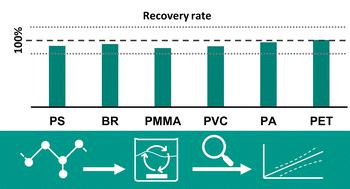Our official English website, www.x-mol.net, welcomes your
feedback! (Note: you will need to create a separate account there.)
Highly selective solid–liquid extraction of microplastic mixtures as a pre-preparation tool for quantitative nuclear magnetic resonance spectroscopy studies
Analyst ( IF 3.6 ) Pub Date : 2024-09-27 , DOI: 10.1039/d4an00991f Marcel Günther, Wolfgang Imhof
Analyst ( IF 3.6 ) Pub Date : 2024-09-27 , DOI: 10.1039/d4an00991f Marcel Günther, Wolfgang Imhof

|
Despite various developments in the application of quantitative nuclear magnetic resonance (qNMR) spectroscopy toward microplastics in recent years, this method still lacks suitable sample preparation and fractionation procedures. As this poses a crucial obstacle for its utilisation on environmental samples, which contain various mixtures of polymers along with other matrix substances, this research aims to address this missing link by presenting an easy-to-apply procedure based on common laboratory equipment. The process selectively separates microplastics from inorganic constituents while performing the necessary fractionation of different types of microplastics prior to qNMR analysis. It allows subsequent quantification of polystyrene (PS), polybutadiene rubber (BR), polymethylmethacrylate (PMMA), polyvinylchloride (PVC), polyethylene terephthalate (PET) and polyamide (PA) from a single sample, establishing recovery rates greater than 88% for all tested polymer types. Additionally, we extended our previous qNMR protocol to include two common polymer types: polymethylmethacrylate (PMMA) and polyacrylonitrile (PAN), achieving limits of detection down to 1.76 μg ml−1 and 12.53 μg ml−1 as well as limits of quantification down to 5.88 μg ml−1 and 41.78 μg ml−1, respectively. Thus, the qNMR method presented herein is now applicable to eight abundant polymer types, allowing the quantification of up to three different types simultaneously.
中文翻译:

高选择性固液萃取微塑料混合物作为定量核磁共振波谱研究的预制备工具
尽管近年来定量核磁共振(qNMR)光谱在微塑料方面的应用取得了各种进展,但该方法仍然缺乏合适的样品制备和分级程序。由于这对其在含有各种聚合物和其他基质物质的混合物的环境样品中的利用造成了重大障碍,因此本研究旨在通过提出一种基于常见实验室设备的易于应用的程序来解决这个缺失的环节。该工艺选择性地将微塑料与无机成分分离,同时在 qNMR 分析之前对不同类型的微塑料进行必要的分级。它允许对单个样品中的聚苯乙烯 (PS)、聚丁二烯橡胶 (BR)、聚甲基丙烯酸甲酯 (PMMA)、聚氯乙烯 (PVC)、聚对苯二甲酸乙二醇酯 (PET) 和聚酰胺 (PA) 进行后续定量,所有样品的回收率均大于 88%测试的聚合物类型。此外,我们扩展了之前的 qNMR 协议,包括两种常见的聚合物类型:聚甲基丙烯酸甲酯 (PMMA) 和聚丙烯腈 (PAN),实现检测限低至 1.76 μg ml -1和 12.53 μg ml -1以及定量限低至分别为5.88μgml -1和41.78μgml -1 。因此,本文提出的 qNMR 方法现在适用于八种丰富的聚合物类型,允许同时定量多达三种不同类型。
更新日期:2024-09-27
中文翻译:

高选择性固液萃取微塑料混合物作为定量核磁共振波谱研究的预制备工具
尽管近年来定量核磁共振(qNMR)光谱在微塑料方面的应用取得了各种进展,但该方法仍然缺乏合适的样品制备和分级程序。由于这对其在含有各种聚合物和其他基质物质的混合物的环境样品中的利用造成了重大障碍,因此本研究旨在通过提出一种基于常见实验室设备的易于应用的程序来解决这个缺失的环节。该工艺选择性地将微塑料与无机成分分离,同时在 qNMR 分析之前对不同类型的微塑料进行必要的分级。它允许对单个样品中的聚苯乙烯 (PS)、聚丁二烯橡胶 (BR)、聚甲基丙烯酸甲酯 (PMMA)、聚氯乙烯 (PVC)、聚对苯二甲酸乙二醇酯 (PET) 和聚酰胺 (PA) 进行后续定量,所有样品的回收率均大于 88%测试的聚合物类型。此外,我们扩展了之前的 qNMR 协议,包括两种常见的聚合物类型:聚甲基丙烯酸甲酯 (PMMA) 和聚丙烯腈 (PAN),实现检测限低至 1.76 μg ml -1和 12.53 μg ml -1以及定量限低至分别为5.88μgml -1和41.78μgml -1 。因此,本文提出的 qNMR 方法现在适用于八种丰富的聚合物类型,允许同时定量多达三种不同类型。


















































 京公网安备 11010802027423号
京公网安备 11010802027423号